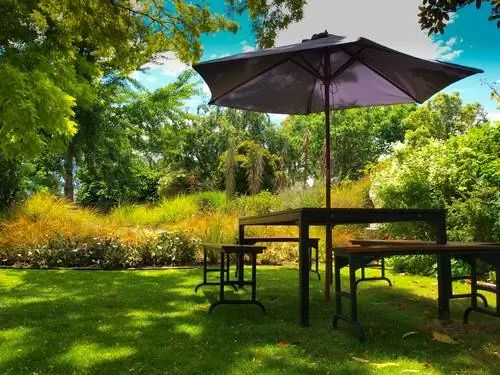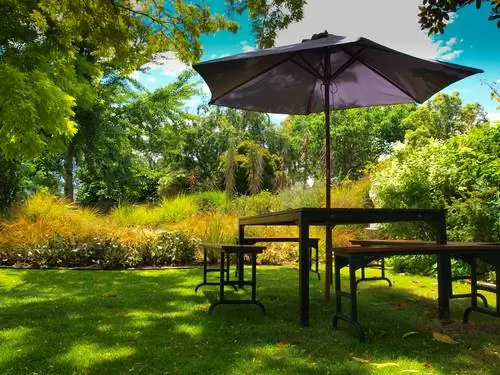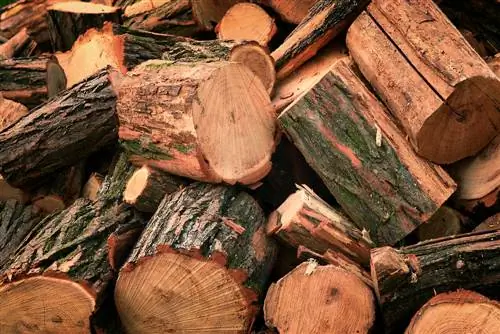- Author admin [email protected].
- Public 2023-12-24 06:09.
- Last modified 2025-01-23 11:22.
This summer they will also be found in numerous gardens all over Germany: parasols. The popular all-purpose weapon against heat, rain and UV radiation not only offers practical added value, but is also considered by most garden enthusiasts to be a modern eye-catcher and the center of their own oasis of well-being.

Why are parasols a practical and visual added value?
Parasols offer practical protection from heat, rain and UV radiation as well as visual added value in the garden or on the terrace. There are two main types: the center pole umbrella for high stability and the cantilever umbrella for larger shade area and better sun protection.
Spring is coming to an end and the warm summer months promise great barbecues in your own garden this year too. It's only understandable that many garden owners are already looking for new garden furniture - and attach particular importance to a very special accessory: the parasol.
Not all parasols are the same - but what are the differences (actually)?
If you think that parasols basically all look the same, you are wrong - because due to the ever-growing popularity, there is no longer just the "classic" parasol that you still know from your grandparents' garden. Instead, nowadays a distinction is made between the so-called center-pole umbrella and the cantilever umbrella. Both variants are suitable for use in the garden as well as on the balcony or your own terrace. But what is the difference between the two models? And what else should you pay attention to when choosing the right parasol?
The center pole umbrella: This variant is probably the most well-known type of parasol. The center pole umbrella, also commonly known by the alternative names pole, market or center pole umbrella, has a pole that is located exactly in the middle of the parasol. This structure ensures high stability and also makes it possible to use the entire area underneath the umbrella. However, the often quite large umbrella stand and the centered mast occasionally cause problems, as the garden table and the matching seating group have to be built around the stand. A little tip: If the garden table has a suitable hole in the middle, the pole can easily be guided through there. This saves a lot of space and ensures that the pole doesn't bother anyone.
The cantilever umbrella: Probably the most obvious difference to the center pole umbrella mentioned above is the position of the umbrella stand and the mast. These are not in the middle of the traffic light or free-arm umbrella, but outside the actual umbrella area. In addition, the mast is not attached below the roof, but above it. Due to this special design, the cantilever umbrella offers a larger shade area overall, which also enables better sun protection. Most cantilever umbrellas have a crank that is attached to the pole and is intended to align the umbrella. With this practical tool, the parasol can be adjusted to the respective lighting conditions in no time. However, things become difficult in strong winds, as the cantilever parasol is not as stable as the center pole parasol due to the position of the mast and the stand cross - as well as the associated larger attack surface.
What should you pay attention to when buying a new parasol?
First of all, the new parasol should of course correspond to your personal taste, especially in terms of shape, size and color. However, you should consider a few things in advance, such as where the umbrella should stand later. For example, is it a location that is more sheltered from the wind or does the parasol need to be as stable as possible? And what material should it be made of: weatherproof aluminum, plastic or rather FSC-certified and sustainably produced wood? There is also the question of the right covering. In addition to the extremely durable polyacrylic and polyester umbrellas, there are now more and more parasols made from awning fabric.
The choice of the right material should be made primarily with durability in mind. The parasol must withstand a wide range of weather conditions and ideally should also offer a high level of UV protection. A good indicator of this is the so-called UPF seal, which indicates the UV protection factor. The following applies here: the higher the value, the better the UV protection. The information page of the Federal Office for Radiation Protection (BfS) shows how important such protection can be for the skin. And if you want to use your parasol for a long time, it is best to protect it from the most adverse weather conditions with a protective cover or cover. This ensures a significantly longer lifespan for the parasol and elegantly prevents potential damage.






